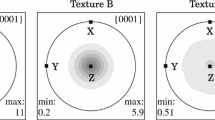Conclusions
-
1.
The analytical approach used in this work provides high accurary in calculation of the averaged elastic constants of close-packed hexagonal materials with axial texture. In contrast to other approaches to averaging, the distribution function of the crystallites with respect to orientations is represented by a Gauss distribution. This significantly simplifies the averaging procedure and analysis of the behavior of the elastic constants. The analysis of the relationship of the elastic constants to the direction of the crystallographic axis of the texture and the dispersion of the texture made it possible to detect a number of anomalies in their behavior. The appearance of the anomalies is not the same for the different averaged elastic constants in relation to the degree of anisotropy.
-
2.
With a dispersion in structure of σ→90° isotropy is reached in practice regardless of the orientation the axis of the texture. A deviation in the axis of the texture from the [0001] direction by an angle of ∼50° leads to the minimum anisotropy of the averaged values regardless of the amount of dispersion in texture.
Similar content being viewed by others
Literature Cited
T. D. Shermergor, The Theory of Elasticity of Microinhomogeneous Media [in Russian], Nauka, Moscow (1977).
H. J. Bunge, “Über die elastischen Konstanten kubischer Materialien mit beliebiger Textur”, U-Kristall und Technik,3, No. 3, 431–438 (1968).
H. J. Bunge, “Mathematische Methoden der Texturanalyse”, Akad. Verl., Berlin (1969).
E. Kroner, “Berechnung der elastichen Konstanten des Vielkristalls aus den Konstanten des Einkristalls”, Z. Phys.,151, No. 4, 504–518 (1958).
C. M. Sayers, “The strain distribution in anisotropic polycrystalline aggregates subjected to an external stress field”, Philos. Mag.,49A, No. 2, 243–262 (1984).
G. Kneer, “Über die Berechnung der Elastizitätsmoduln Vielkristalliner Aggregate mit Textur” Phys. Status Solidi,9, No. 3, 825–838 (1965).
G. Vasserman and I. Greven, The Texture of Metallic Materials [in Russian], Metallurgiya, Moscow (1969).
E. A. Mityushov, R. A. Adamesku, and V. I. Yushkov, “The elastic properties of metals with cubic symmetry having axial texture”, Fiz. Met. Metalloved.,55, No. 6, 1079–1082 (1983).
A. Kelly and G. Groves, Crystallography and Defects in Crystals [Russian translation], Mir, Moscow (1974).
M. Yositsugu, O. Tadatsune, H. Sigeo, and I. Tomidziro, “Sogo sikensyo nempo” Ann. Rept. Eng. Res. Inst. Fac. Eng. Univ. Tokyo,24, No. 2, 89–91 (1966).
A. A. Vainshtein, P. S. Rusinov, and N. V. Papina, “Nonuniformity of the properties of polycrystalline materials with axial texture”, Fiz. Met. Metalloved.,48, No. 5, 957–961 (1983).
Additional information
Institute of Metal Physics, Academy of Sciences of the Ukrainian SSR, Kiev. Translated from Problemy Prochnosti, No. 2, pp. 61–65, February, 1988.
Rights and permissions
About this article
Cite this article
Dneprenko, V.N., Larikov, L.N. & Schiritsa, A.I. Elastic properties of textured metals with a hexagonal lattice. Strength Mater 20, 205–210 (1988). https://doi.org/10.1007/BF01522925
Received:
Issue Date:
DOI: https://doi.org/10.1007/BF01522925




